This is an Earthcache – as such, there is no physical cache. Instead after examining the specimen at both posted coordinates you will answer 5 questions and message me the answers. This earthcache is located on the grounds of the George Washington Masonic National Memorial and can only be visited during daylight hours. That being said this is private property and this is placed with permission. Jogging, Exercising, Skateboarding, and Rollerblading on the grounds are Prohibited.
George Washington Masonic National Memorial and the Alexandria World War I Memorial

On June 5, 1922 construction began on the nearby George Washington Masonic National Memorial. Much of the stone used in the construction of this building comes from Redstone, NH. The Maine and New Hampshire Granite Co owned the two quarries that produced two different colors of granite used in this project: pink and green. Even more interesting is that these two quarries at Redstone lie within a few hundred yards of each other. This makes their geological proximity considered a fairly rare occurrence. On the figure below you can see the two quarries and the red dividing line that seperates them.
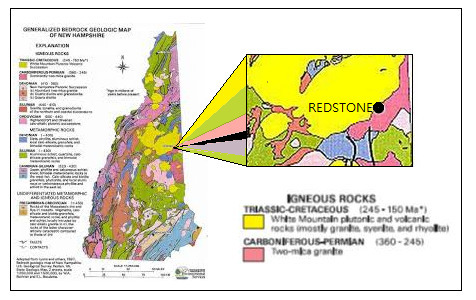
Supplying granite for this seven-story building was the largest job ever undertaken at Redstone. The local freight yard was expanded into one of the largest railroad yards on the East coast from the amount of freight generated for this project. Included in this construction were twenty-four polished green interior columns, the large pink columns at the front entrance, and close to a mile of blocks used for the steps. All of this granite arrived here by rail at the nearby Alexandria Union Station. Despite the numerous over-runs on this construction, the George Washington Masonic Memorial was finally dedicated in 1932.
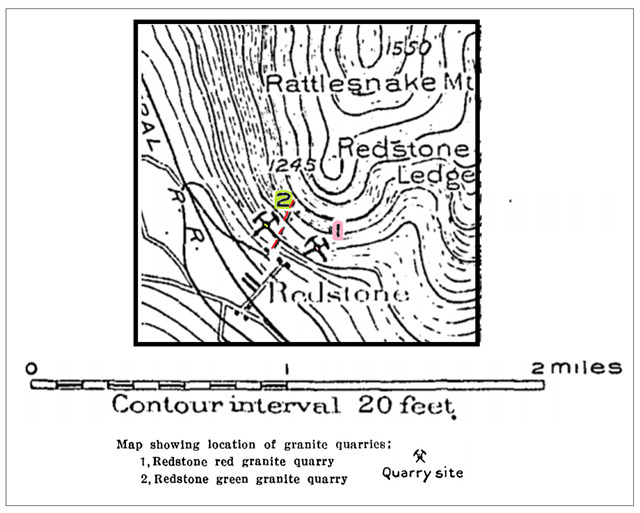
Each of these 18 foot, 4.5 feet diameter,11 to 18 tons columns were shipped to the nearby Alexandria Union Station. One of the columns arrived damaged and could not be used in the construction of the George Washington Masonic Memorial. That damaged column was then donated to the local Ladies Auxiliary of the Veterans of Foreign Wars. In 1940 a memorial for Alexandria War Dead was erected from that column here at Alexandria Union Station.
Granite
Granite is an intrusive igneous rock that begins as a molten liquid state that solidifies as it cools. The texture is now determined by the rate in which it cools. The large mineral crystals in granite are evidence that it cooled slowly from molten rock. That slow cooling occurred beneath the earth's surface and required a long period of time. Granite which cools closer to the earth's surface as when it is exposed to air or water, cools more rapidly and the result is a granite with crystals that are smaller.
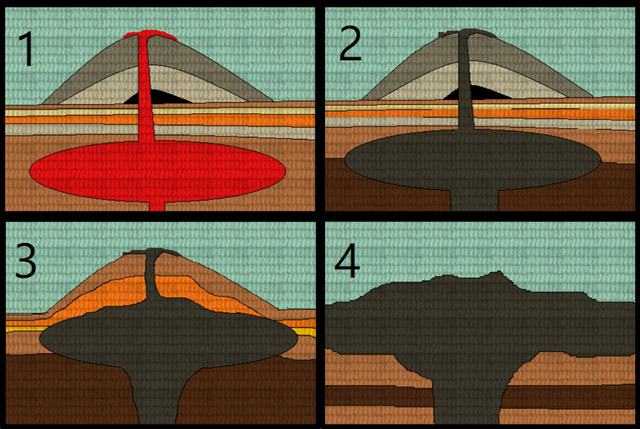
1.) A magma chamber forms. 2.) It slowly cools. 3.) Continued uplifting from tectonic action forms mountain. 4.) Years of surface erosion expose the granite dome at the surface.
Granite comes in a wide variety of colors--greens, blues, reds, browns, yellows, black, white, gray, and more. The pink color of this is from the orthoclase in the stone. Orthoclase is a feldspar mineral and it is most widely known as the pink feldspar found in many granites. It is one of the most abundant rock-forming minerals of the continental crust.

Granite is a rock that is composed of one or more minerals, and minerals are composed of one or more elements.
ELEMENTS: Elements are atoms, the smallest piece that we can split matter into. Different elements have different properties.
MINERALS: Elements often are stacked together with other elements to form minerals. Minerals are simply a collection of one or more elements that are stacked neatly together in a form called a crystal structure.
ROCKS: Rocks are a composed of one or more minerals. A rock can be made up of only one mineral or, as shown in the figure, a rock can be made up of a number of different minerals.
The granite "Redstone Pink," is a biotite granite of light pinkish-gray color with large dark-gray and small black spots. The granite "Redstone Green" is a biotite-hornblende granite of dark-yellow greenish color with black spots.
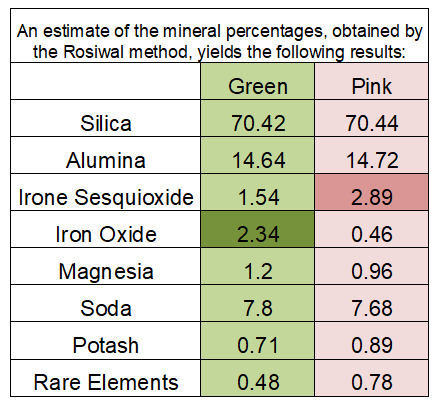
It will be noticed, on comparing the amounts of iron oxides in the green granite and the red granite that the green exceeds the other by 1 percent, which is attributable to its larger content of hornblende and allanite and of the limonite proceeding therefrom. Iron (II) Oxide (which is in higher abundance in the green granite) actually reacts with water to form hydroxides which give the green color.
LOGGING REQUIREMENTS:
To log this Earthcache: Read the geology lesson above. Go to both waypoints, use the chart below to record your observations, and answer the 4 geology questions. Answers can be sent via e-mail or messenger contacts on my Geocaching profile. Do not post the answers to the questions in your logs.
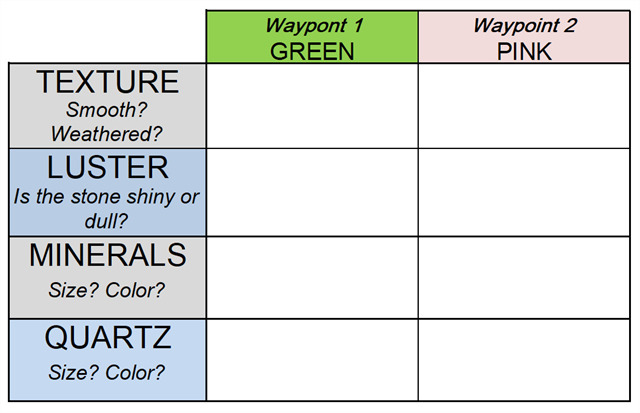
QUESTION 1. Which stone has a smoother texture?
QUESTION 2. Which stone has more luster? Is that due to a one having larger quartz crystals?
QUESTION 3. Knowing that slow cooling magma gives the distinct minerals in the rock time to consolidate into large crystals, which of these two stones cooled slower forming larger crystals?
QUESTION 4. At waypoint #2 there is a plaque on the wall from September 14, 1999 commemerating the 200th anniversary of the death of George Washington. Is the plaque carved in Redstone Pink Granite or Redstone Green Granite?
QUESTION 5. After observing both stones are you surprised that these two stones where found so close together?
POST PHOTO. Posting a photo that readily indicates that you (and anyone else logging the find) are at the location. You do not have to show your face, but the photo should be personalized by you or a personal item. Your background should include a view of the Alexandria World War I Memorial or George Washington Masonic Memorial. NOTE: Per newly published Earthcache guidelines, this requirement is REQUIRED to claim the find.
 Placed by a proud member of both
Placed by a proud member of both

 Awesnap has earned GSA's highest level:
Awesnap has earned GSA's highest level:


REFERENCES:
1. The Commercial Granites of New England, Quarries, Department of the Interior, pages 168-169, 1923, pubs.usgs.gov
2. A history of the Town of Redstone and Its Granite Quarries, Steve Swenson and Rick Russack, redstonequarrynh.org
3. George Washington Masonic National Memorial, Construction milestones, wikipedia.com
4. The Town of Redstone and Its Granite Quarries, Steve Swenson and Rick Russack, whitemountainhistory.org
5. The Granite of Conway, New Hampshire, and it's Druse Minerals, Joseph Gillson, American Mineralogist, Volume 12, pages 307-319, 1927
6. The Geologic Story of the Old Man of the Mountains, New Hampshire Geological Survey, des.nh.gov
7. The Cheif Commercial Granites of Massachusettes, New Hampshire, and Rhode Island, JT. Nelson DaleDepartment of the Interior, Bulletin 354, pages 176-184, 1908 books.google.com